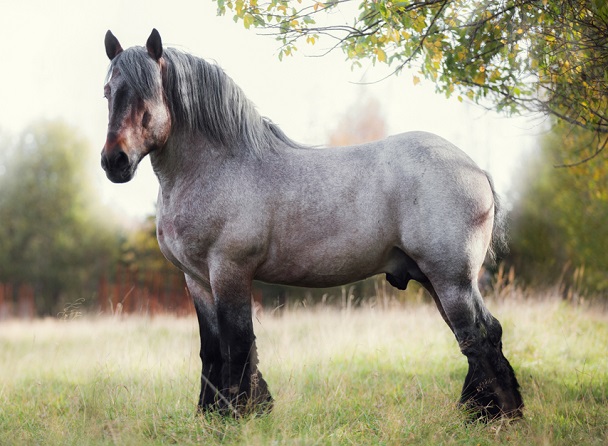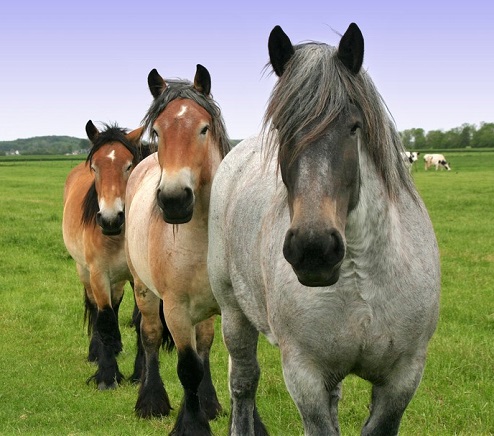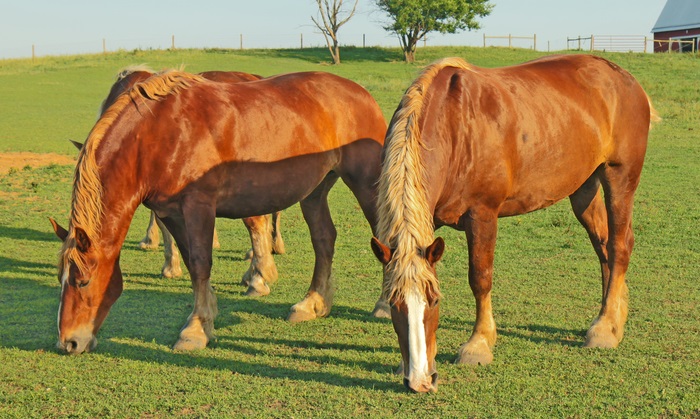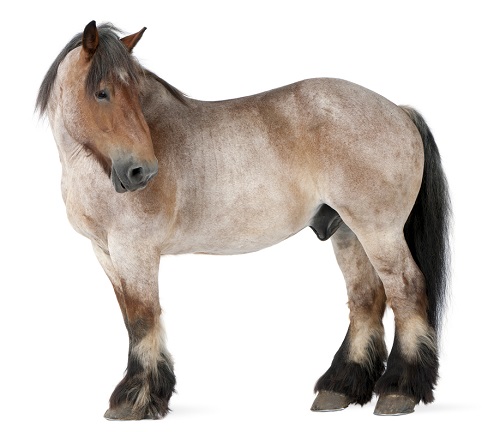Belgian Draft Horses are giants in the equestrian world. Their massive size comes with immense pulling power, coupled with a gentle spirit and kind heart. These wonderful horses are increasingly popular in the United States, and not just as a workhorse, but also as a riding horse and pet.
Also known as the Belgian, the breed originally comes from the Brabant region of Belgium. Although its home country nurtured the breed into existence, it was the United States that developed the Belgian into its modern form.
While these horses are quite slender for a heavy draft, they are not lacking in power. Belgian Drafts have set numerous world records throughout the breed’s history, and they don’t fail to amaze us today.
Here are ten fascinating facts about the Belgian Draft Horse!
1. Belgian Drafts Likely Descend From Medieval War Horses
It is plain to see that Belgian Drafts resemble the mighty destriers of the Middle Ages. They are blessed with strong bone, tall stature, and abundant muscling still fit to carry a knight. Many sources agree that Belgian Drafts are direct descendents of the medieval “Great Horse”, although there is no evidence to support this.

Olesya Nickolaeva / Shutterstock.com
According to the FEI, selective breeding of the Belgian Draft Horse began in the 17th century. Since Belgium has fertile soil and abundant rainfall, there was no shortage of crops to support the creation of heavy horse breeds. Alongside the Belgian, other related horse breeds emerged from the country, such as the Ardennais and Dutch Draft.
The foundation stock used to develop the Belgian Draft consisted of Brabant horses. In fact, the two breeds were essentially the same until the 1940s, when the United States took over the breeding of Belgian Drafts. Some sources still use “Belgian” and “Brabant” interchangeably, however, this is incorrect.
Also Read: 7 Medieval War Horse Breeds
2. The Modern Belgian Draft Horse Was Developed In America
Although the breed began its journey in Belgium, the Americans took the reins of breeding from the late 19th century. To keep records of all the Belgian Draft Horses in the States, the American Association of Importers and Breeders of Belgian Draft Horses was founded in 1887.
The organization later became known as the Belgian Draft Horse Corporation of America, which is now the official governing body of the breed. From its headquarters in Wabash, Indiana, the corporation oversees registrations, issues breed standards, and organizes breed-specific events across the country.

The popularity of the Belgian Draft in the United States began to rise after the breed appeared at the St. Louis World Fair in 1903. There was a consistent influx of Belgian horses into America until the Second World War. The last Belgian Drafts left Europe with Erwin F. Dygert, after which imports were completely cut off.
Similar to other draft horse breeds, the mechanization of agriculture and transport took a toll on the Belgian Draft. As the interest in draft horse breeding declined, so did the annual registrations.
According to the International Museum of the Horse, less than 200 new horses were registered with the breed society during the early ’50s.
Luckily, the price of draft horses began to increase towards the end of the century, and so the breed recovered. Between 1980 and 1985, the Belgian Draft reached its all-time high with an average of 4,000 registrations.
Today, the Belgian is the most popular draft horse breed in the United States, outnumbering all other heavy breeds put together!
3. The American Belgian Draft Differs From The European Type
When the Belgian Draft first set foot in the United States, many people disliked its thick outline, round bones, and straight shoulders. On the other hand, they appreciated the breed’s work ethic, docile temperament, and economical upkeep. And so, American breeders decided to make changes to the Belgian Draft while keeping its best qualities.
The American Belgian Draft became taller and lighter than its European cousin, with sloping shoulders and flat bone. It still retained its flawless manners, pulling power, and willingness to work. Meanwhile, the Brabant in Europe developed into a thick and heavy workhorse with coarse features and abundant feathering.

Annelie Carlsson / Shutterstock.com
While the Brabant and Belgian are both great workers, the latter breed also has a talent for driving. Belgian Drafts regularly take part in both pulling and driving competitions, which further highlights the breed’s versatility.
4. Most Belgians Are Chestnut With A Flaxen Mane And Tail
Before the American influence, Belgian Drafts came in a variety of coat colors. The most common color was bay, but chestnuts, roans, and grays were also typical.
By the ’20s and ’30s, the predominant colors in the breed were chestnut and roan. American breeders also selected for a flaxen mane and tail, a white blaze, and four white socks.
Over time, chestnut became the sole desirable color in the breed. Hence why most Belgian Drafts today have chestnut coats. Although roans and bays also occur, they are becoming less and less common, while gray Belgians are an extremely rare sight.

Stephen B. Goodwin / Shutterstock.com 5. One Of The Strongest Draft Horse Breeds
All that muscle and bone on a Belgian Draft is not only for showing purposes. An average Belgian can pull up to 8,000 pounds (3628.7 kg) of load, which is over twice their weight. They can also labor 8 to 10 hours a day without growing tired.
There are many examples of Belgian Drafts pulling impressive weights on the record. A team of Belgians, collectively weighing 4,800 pounds (2,200 kg), once pulled 17,000 pounds (7,700 kg) a distance of 7 ft 2 (2.18 m) at the National Western Stock Show in Denver, Colorado.
Another memorable demonstration of the Belgian’s power happened at the Iowa State fair pulling contest. A pair of Belgian and Percheron horses weighing 3,600 pounds (1,600 kg) pulled 14,600 pounds (6,690 kg) a distance of 15 ft 4.6 m). While the Shire horses might hold the world record for pulling, Belgian Drafts are not far behind!
Also Read: How Much Weight Can a Horse Pull?
6. The Belgian Draft Was Originally A Farm Horse
Since the early days of the breed, Belgian Drafts have been bred for agricultural and industrial work. Its strong bones and heavy muscling make the breed ideal for pulling plows, towing barges and transporting heavy goods.
While Belgians are still used for forestry and farm work today, they have become popular in various equestrian disciplines.
Besides pulling contests, Belgian Drafts have also been seen on shows, driving competitions, and even dressage events. Admirers of this charming breed sometimes keep them as pets or pleasure riding/driving horses.

Grietje Boer / Shutterstock.com 7. The Average Weight Of A Belgian Draft Is Nearly A Ton
Belgian Drafts are undoubtedly one of the heaviest equines on the planet. A newborn foal already weighs around 125 pounds (56.7 kg), while a fully grown adult weighs over 2,000 pounds (900 kg) on average.
Part of the reason why Belgian Drafts grow so heavy is their above-average height. A Belgian usually stands between 16.2 and 18 hands at the withers, which is on the tall end of the spectrum. Their weight can range from 1,800 to 2,400 pounds (800 to 1,100 kilograms), with mares usually lighter than stallions.
Also Read: How Much Does an Average Horse Weigh?
8. The Largest Belgian Draft Stood Over 20.2 Hands Tall
Until recently, the world’s largest living horse was a Belgian Draft gelding called Big Jake. Born in 2001, the horse matured at 20.2 3⁄4 hands (210 cm), making him one of the largest horses in history. Interestingly, Big jake weighed 2,600 pounds (1179 kg) fully grown, which is just over average for his breed.
This monumental chestnut earned his Guinness World Record holder title in 2010. He lived to the age of 20, passing away in June 2021. Read more about Big Jake here.
Included in our biggest horses ever list, a Belgian Draft called Brooklyn Supreme stood at a massive 19.2 hands tall and weighed a whopping 3,200 pounds (1,451.5 kg). He also lived to the age of 20 and died in 1948.

Brooklyn Supreme 9. The World’s Most Expensive Draft Horse Was A Belgian
and even fully trained Belgian Drafts are in the under $10,000 category. In contrast, a show jumping or dressage prospect will set you back tens of thousands of dollars on average.
Even so, the most expensive draft horse ever purchased turned out to be a Belgian Draft. According to the Guinness World Records, the 2-year-old Belgian stallion Mcllrath’s Captain Jim was bought for an eye-watering $112,500!
McIlrath’s Captain Jim was sold from the stables of William Helmuth & Allen F. Detweiler. It was James A. Raber and Orla W. Yoder who bought the young stallion for a record price at the Illinois Mid-America Draft Horse Sale in February 2003.

Eric Isselee / Shutterstock.com 10. Belgian Draft Horses Are Low Maintenance
Most people wouldn’t expect such large and heavy horses to be easy keepers. However, Belgian Drafts are surprisingly economical to keep and don’t require much grain and supplements to put on weight. They are also happy to live out all year round, regardless of weather.
However, when there is abundant food available, a Belgian Draft can eat over 50 pounds (22.7 kg) of forage a day. If they are actively working or exercising, their appetite can be even bigger.
With that being said, there is no need for fancy concentrate feeds to keep them in good condition; a forage-only diet will suffice.
Source: horseyhooves.com








